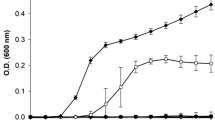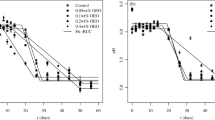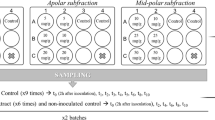Abstract
The effectiveness of rosemary and thyme oils as antimicrobial agents in mozzarella cheese against Listeria monocytogenes, lactic acid bacteria (LAB), and total aerobic bacteria (TAB) was evaluated. In low fat cheese, rosemary and thyme oils inhibited L. monocytogenes by 0.5 and 1.0 log CFU/g, respectively, and by 1.7 log CFU/g in combination on day 20 at 4°C. Combination of rosemary and thyme oils inhibited growth of L. monocytogenes and LAB in low fat cheese, but not in full fat cheese. Rosemary and thyme oils with sodium diacetate were more effective for inhibition of L. monocytogenes than oil alone. Essential oils have potential applications for inhibition of indigenous microorganisms in low fat food products, and for controlling growth of L. monocytogenes after post-processing contamination. The oils also showed potential for inhibition of microorganisms in full fat products in combination with sodium diacetate.
Similar content being viewed by others
References
Millet L, Saubusse M, Didienne R, Tessier L. Control of Listeria monocytogenes in raw-milk cheeses. Int. J. Food Microbiol. 108: 105–114 (2006)
Lemay MJ, Choquette J, Delaquis PJ, Gariepy C, Rofrigue N, Saucier L. Antimicrobial effect of natural preservatives in a cooked and acidified chicken meat model. Int. J. Food Microbiol. 78: 217–226 (2002)
Kim IH, Lee HN, Kim JE, Song KB, Lee YS, Chung DS, Min SC. Plum coatings of lemongrass oil-incorporating carnauba wax-based nanoemulsion. J. Food Sci. 78: 1551–1559 (2013)
Mangena T, Muyima NYO. Comparative evaluation of the antimicrobial activities of essential oils of Artemisia afra, Pteronia incana and Rosemarinus officinalis on selected bacteria and yeast strains. Lett. Appl. Microbiol. 28: 291–296 (1999)
Bayder H, Sağdiç, O, Özkan, G, Karadoğan T. Antibacterial activity and composition of essential oils from Origanum, Thymbra and Satureja species with commercial importance in Turkey. Food Control 15: 169–172 (2004)
Bhaskara Reddy MV, Angers P, Gosselin A, Arul J. Characterization and use of essential oil from Thymus vulgaris against Botrytis cinerea and Rhizopus stolonifer in strawberry fruits. Phytochemistry 47: 1515–1520 (1998)
Firouzi R, Azadbakht M, Nabinedjad A. Anti-listerial activity of essential oils of some plants. J. Appl. Anim. Res. 14: 75–80 (1998)
Abdollahzadeh E, Rezaei M, Hosseini H. Antibacterial activity of plant essential oils and extracts: The role of thyme essential oil, nisin, and their combination to control Listeria monocytogenes. Food Control 35: 177–183 (2014)
Singh A, Singh RK, Bhunia AK, Singh N. Efficacy of plant essential oils as antimicrobial agents against Listeria monocytogenes in hotdogs. Lebensm. Wiss. Technol. 36: 787–794 (2003)
Sofos JN, Busta FF. Antimicrobial activity of sorbate. J. Food Protect. 44: 614–622 (1981)
Seo S, Jung D, Wang X, Seo DJ, Lee MH, Lee B-H, Choi C. Combined effect of lactic acid bacteria and citric acid on Escherichia coli O157:H7 and Salmonella Typhimurium. Food Sci. Biotechnol. 22: 1171–1174 (2013)
Burl S, Coote P. Preservative agents in foods. Mode of action and microbial resistance mechanism. Int. J. Food Microbiol. 50: 1–17 (1999)
Stekelenburg FK. Enhanced inhibition of Listeria monocytogenes in Frankfurter sausage by the addition of potassium lactate and sodium diacetate mixtures. Food Microbiol. 20: 133–137 (2003)
Min K-J, Kwon K-Y, Yoon K-S. Effect of different antimicrobials on the growth kinetics of foodborne pathogens in ready-to-eat, Pyeonyuk (cooked and pressed pork). Food Sci. Biotechnol. 19: 99–106 (2010)
Kosikowski FV, Mistry VV. Cheese and fermented milk foods. Procedure and analysis. Vol. II, pp. 61–81. In: Soft Italian Cheese-mozzarella and Ricotta. Kosikowski FV, Mistry VV (eds). Kosikowski Pub, Westport, CT, USA (1997)
AOAC. Official Methods of Analysis of AOAC Intl. 14th ed. Method 7.003. Association of Official Analytical Chemists, Arlington, VA, USA (1984)
Case RA, Bradley RL, Williams RR. Chemical and physical methods. pp. 327–404. In: Standard Methods for Examination of Dairy Products. Richardson GH (ed). American Public Health Association, Washington, DC, USA (1985)
Bergamo P, Fedele E, Iannibelli L, Marzillo G. Fat-soluble vitamin contents and fatty acid composition in organic and conventional Italian dairy products. Food Chem. 82: 625–631 (2003)
Olarte C, Gonzalez-Fandos E, Gimenez M, Sanz S, Portu J. The growth of Listeria monocytogenes in fresh goat cheese (Cameros cheese) packaged under modified atmospheres. Food Microbiol. 19: 75–82 (2002)
Sabia C, Niederhausern S, Messi P, Manicardi G, Bondi M. Bacteriocin-producing Enterococcus casseliflavus IM 416K1, a natural antagonist for control of Listeria monocytogenes in Italian sausages (“cacciatore”). Int. J. Food Microbiol. 87: 173–179 (2003)
Cutter CN. Antimicrobial effect of herb extracts against Escherichia coli O157:H7, Listeria monocytogenes, and Salmonella Typhimurium associated with beef. J. Food Protect. 63: 601–607 (2000)
Gill AO, Delaquis P, Russo P, Holley RA. Evaluation of antilisterial action of cilantro oil on vacuum packed ham. Int. J. Food Microbiol. 73: 83–92 (2002)
Smith-Palmer A, Stewart J, Fyfe L. The potential application of plant essential oils as natural food preservatives in soft cheese. Food Microbiol. 18: 463–470 (2001)
Farbood MI, MacNeil JH, Ostovar K. Effect of rosemary spice extractive on growth of microorganisms in meats. J. Milk Food Technol. 39: 675–679 (1976)
Barmpalia IM, Koutsoumanis KP, Geornaras I, Belk KE, Scanga JA, Kendall PA, Smith GC, Sofos JN. Effect of antimicrobials as ingredients of pork bologna for Listeria monocytogenes control during storage at 4 or 10°C. Food Microbiol. 22: 205–211 (2005)
Goulas AE, Kontominas MG. Combined effect of light salting, modified atmosphere packaging and oregano essential oil on the shelf-life of sea bream (Sparus aurata): Biochemical and sensory attributes. Food Chem. 100: 287–296 (2007)
Author information
Authors and Affiliations
Corresponding author
Rights and permissions
About this article
Cite this article
Han, J.H., Patel, D., Kim, J.E. et al. Microbial inhibition in mozzarella cheese using rosemary and thyme oils in combination with sodium diacetate. Food Sci Biotechnol 24, 75–84 (2015). https://doi.org/10.1007/s10068-015-0012-4
Received:
Revised:
Accepted:
Published:
Issue Date:
DOI: https://doi.org/10.1007/s10068-015-0012-4




